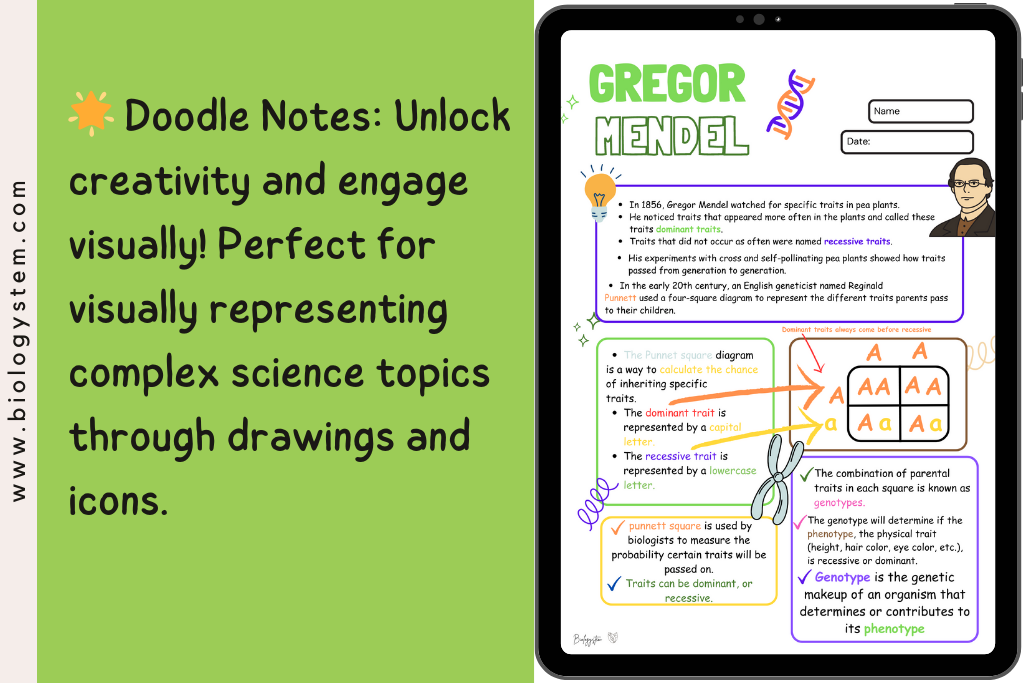Introduction:
Welcome to the world of science education, where success lies in the art of effective note-taking. In this blog post, we’ll unveil the ‘3 Secrets to Effective Science Notes.’ These secrets are your keys to mastering science education and unlocking a deeper understanding of intricate scientific concepts. As we explore Cornell Notes, Doodle Notes, and Scaffolded Notes, you’ll discover how to choose your path to academic excellence. Let’s embark on this journey of scientific discovery and enhanced learning.

Cornell Notes: Structured Learning
Format:
Cornell Notes come to life in a two-column structure, with one column for primary notes and another for cues, questions, or a summary section. It’s like a blueprint for active reading and note-taking.

Mendelian Genetics Cornell Notes
Purpose:
The structure of Cornell Notes fosters active engagement. The cue or question column becomes a student’s study companion, helping them test their knowledge by covering the main notes and quizzing themselves using the cues. It’s about more than just taking notes; it’s about studying smarter.
Doodle Notes: Unleashing Creativity
Format:
Doodle Notes defy the conventional with their embrace of artistic and visual elements. Alongside the traditional text, you’ll find drawings, diagrams, icons, and other visual representations. It’s an artistic canvas for scientific learning.

Purpose:
These notes are designed to spark creativity and engage students in a visual and artistic learning process. Complex or abstract scientific concepts find clarity through the stroke of a pen or a splash of color. Doodle Notes make science a work of art.
Scaffolded Notes: Guided Learning
Format:
Scaffolded Notes provide a structured template, often with outlines, prompts, or partially filled-in content. They’re like the training wheels of note-taking, offering guidance to students.

Purpose:
These notes are the safety net for those who may need extra support in organizing information. Especially valuable for newcomers to a subject, Scaffolded Notes break down complex scientific processes into manageable, step-by-step chunks. It’s note-taking with a built-in GPS.
Choosing the Right Notes for Science:
In the realm of biology and science education, the choice of note-taking method should align with your learning objectives, the subject matter at hand, and the preferences of both educators and students.
- Cornell Notes: Perfect for organizing key concepts, vocabulary, and essential information. They’re your reliable companions for active reading and thorough study sessions.
- Doodle Notes: When dealing with visual topics like anatomy or cell structures, Doodle Notes are your creative arsenal. They turn complex scientific imagery into tangible art.
- Scaffolded Notes: For those moments when you need to simplify intricate scientific processes or experiments, Scaffolded Notes offer clarity and structure. They’re the road signs guiding students through the scientific journey.
In the ever-evolving world of science education, adaptability is key. While Cornell Notes traditionally focus on text, there’s room for flexibility. Feel free to infuse them with drawings and visual elements if it enriches the learning experience for your students.
Conclusion:
In the grand mosaic of science education, note-taking methods are the threads that weave understanding. Each technique has its place, and the art lies in choosing the right one to enhance the learning journey. Whether you opt for the structured path of Cornell Notes, the artistic avenue of Doodle Notes, or the guided route of Scaffolded Notes, remember that science is a canvas waiting for you to paint its wonders
